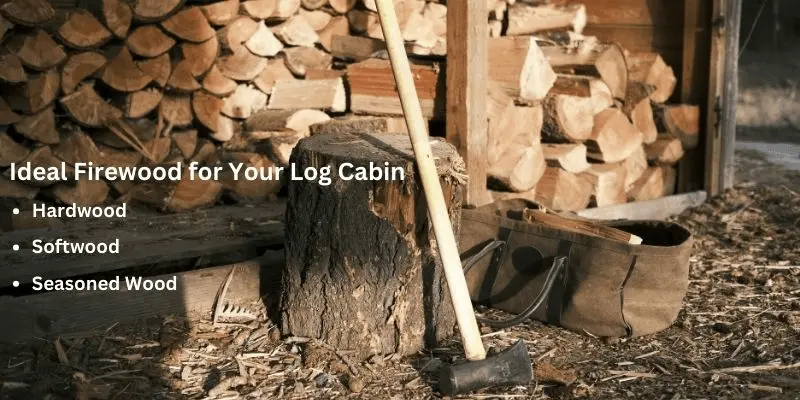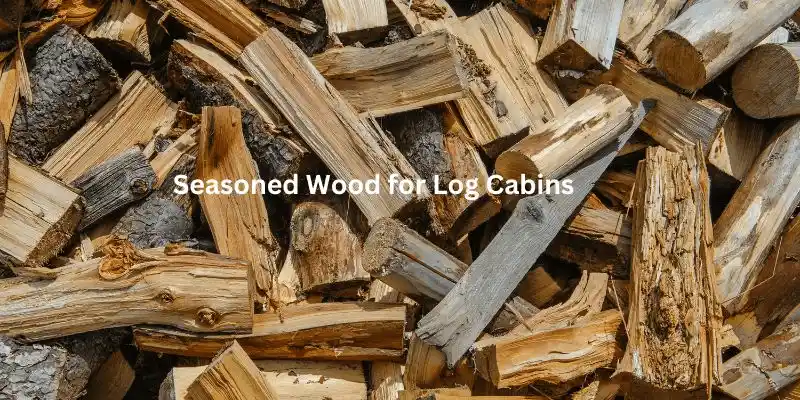Optimizing Comfort: Ideal Firewood for Your Log Cabin | 4 Top Tips
Updated: 31 Jan 2024
219
Log cabins have long been associated with fires crackling in the hearth, throwing a warm glow and providing comfort on chilly days. However, not all firewood is created equal when it comes to heating log cabins efficiently and effectively. Choosing the Ideal Firewood for Your Log Cabin is crucial to ensure a comfortable, well-heated space.
In this comprehensive guide, we will explore the factors to consider when selecting firewood for log cabins, the advantages and disadvantages of hardwood and softwood, the importance of seasoned wood, and the best firewood species for log cabins. Let’s dive in!
Factors to Consider when Selecting Ideal Firewood for your Log Cabins
When selecting firewood for your log cabin, several factors come into play and tips:
- Climate and geographic location
- Type of wood-burning appliance
- Burning efficiency and heat output
These factors will help you choose the most suitable firewood to optimize heating performance and create a pleasant indoor atmosphere.

Hardwood vs. Softwood: Which is best?
Differentiating Hardwood Softwood
Before investigating the advantages and disadvantages of various firewood species, it’s essential to understand the key differences between hardwood and softwood.
Hardwood comes from deciduous trees, such as oak, maple, and hickory, while softwood is obtained from evergreen trees like pine, spruce, and cedar.
Pros and Cons of Hardwood for Log Cabins
1. Oak: Oak is a prized hardwood known for its high density and long burn time. It offers excellent heat output and produces long-lasting coals that are perfect for maintaining a warm fire throughout the night. However, oak can take longer to season fully, so planning is essential.
2. Maple: Maple is another hardwood option that provides a steady heat output, making it ideal for log cabins. It produces relatively minimal smoke and offers a pleasant aroma while burning. Additionally, maple firewood tends to have few sparks or popping, ensuring a safer and more tranquil experience.
3. Hickory: Hickory is a dense hardwood that imparts a pleasant, smoky flavor when used for cooking. Besides its culinary advantages, hickory firewood offers a sustained burn, making it suitable for heating log cabins efficiently. However, hickory can be challenging to ignite, so it is recommended for experienced firewood users.
Pros and Cons of Softwood for Log Cabins
1. Pine: Pine is lightweight softwood that ignites easily and produces a bright, crackling fire. It is often used as kindling due to its resinous nature. However, pine firewood burns quickly, so it is best used as a supplementary wood for initial ignition or in combination with longer-burning hardwoods.
2. Spruce: Spruce is softwood that is readily available and produces a pleasant aroma when burned. It ignites quickly and provides an initial burst of intense heat. However, spruce firewood does not burn as long as hardwoods, necessitating more frequent replenishment.
3. Cedar: Cedar firewood is prized for its pleasant scent and ability to keep away insects. It burns relatively cleanly and produces minimal smoke. However, cedar has a lower heat output compared to hardwoods, so it may be more suitable for mild climates or as a supplemental wood in colder regions.
Seasoned vs. Unseasoned Wood: The Importance of Proper Drying
Understanding Seasoned Wood for Log Cabins
Seasoned wood refers to firewood that has been properly dried to reduce its moisture content. This process is vital for optimal burning efficiency and heat output in log cabins. Unseasoned wood, also known as green wood, contains excessive moisture that inhibits proper combustion.

Benefits of Seasoned Wood
1. Improved Burning Efficiency: Seasoned wood ignites more easily and burns more efficiently, reducing the amount of time and effort spent tending to the fire. It also produces less smoke, minimizing air pollution and ensuring a cleaner indoor environment.
2. Reduced Emissions and Creosote Build-Up: Properly seasoned wood results in fewer harmful emissions such as carbon monoxide and particulate matter. Additionally, the risk of creosote accumulation in the chimney is significantly reduced, minimizing the potential for chimney fires.
3. Enhanced Heat Output: Seasoned wood releases more heat when burned due to its lower moisture content. This allows for more effective heating of log cabins, keeping occupants warm and comfortable even in harsh weather conditions.
Risks and Drawbacks of Unseasoned Wood
1. Increased Smoke and Pollution: Burning unseasoned wood releases a higher volume of smoke and pollutants into the air, negatively impacting indoor air quality and potentially causing respiratory issues. It can also lead to a greater accumulation of soot and residue on furniture and walls.
2. Excessive Creosote Accumulation: Green wood contains higher levels of moisture, leading to increased creosote buildup in chimneys. Creosote is a highly flammable substance that can ignite and cause chimney fires if not regularly cleaned.
3. Insufficient Heat Generation: Unseasoned wood burns less efficiently, resulting in reduced heat output. This can lead to inadequate heating in log cabins, making them less comfortable and inviting during colder months.
Identifying the Best Firewood Species for Log Cabins
Fit for Indoor Fires: Low Smoke and Long-Lasting Embers
1. Birch: Birch firewood is known for its beautiful white bark and aromatic scent. It produces vibrant flames and generates a moderate amount of heat. Birch also forms long-lasting embers, ensuring a warm glow throughout the night.
2. Ash: Ash is highly regarded as an excellent firewood choice, offering a steady heat output and a pleasant fragrance when burned. It produces minimal smoke and creates a robust bed of hot coals, keeping log cabins cozy and well-heated.
3. Cherry: Cherry firewood not only adds a delightful fragrance to log cabins but also creates a warm and steady fire. It burns slowly, producing long-lasting embers that radiate consistent heat, perfect for those quiet evenings indoors.
Ideal for Efficient Heating: High Heat Output and Long Burn Time
1. Beech: Beech firewood is prized for its high energy content, meaning it produces a substantial amount of heat per volume. It burns slowly and steadily, delivering efficient heating performance for log cabins. However, beech firewood can be challenging to ignite, so pairing it with a more easily ignited kindling is recommended.
2. Walnut: Walnut firewood offers a substantial heat output, perfect for colder climates or larger log cabins. It burns slowly, ensuring extended burn times. The rich smell of burning walnut wood adds to the overall experience, creating an inviting atmosphere.
3. Apple: Apple firewood is highly regarded for its excellent heat output and pleasant fragrance. It burns steadily, generating long-lasting warmth while emitting a slight fragrance.
Exceptional All-Rounders: Versatile and Popular Choices
1. Pine (for kindling purposes only): While pine is softwood with relatively lower heat output, it excels as kindling due to its nature. It ignites quickly and easily, helping start the fire efficiently. However, it is advisable to use pine as a supplementary wood combined with longer-burning hardwoods for consistent heating.
2. Elm: Elm firewood offers a good balance of heat output and burn time. It produces a steady flame and generates sufficient warmth for smaller log cabins. Elm wood can be readily available in certain regions and is an excellent option for those seeking a reliable firewood choice.
3. Fir: Fir firewood is known for its ability to light easily and provide a decent amount of heat. It burns relatively quickly, making it suitable for short-term heating or situations where rapid warmth is desired.
Storing and Preparing Firewood for Optimal Performance
Proper Firewood Storage for Log Cabins
To maximize the performance of your firewood, proper storage is essential. Here are some key considerations:
1. Dry and Ventilated Storage Space: Store firewood in a dry, well-ventilated area. A woodshed or covered storage space with open sides is ideal as it allows airflow, preventing moisture buildup that can compromise the quality of firewood.
2. Elevated Storage Platforms: Raise the firewood off the ground by using pallets or a dedicated wood rack.
3. Protecting Firewood from Moisture and Pests: Cover the top of the firewood stack with a tarp or waterproof cover to shield it from rain and snow. Additionally, keep the woodpile away from structures.
Preparing Firewood for Efficient Burning
1. Cutting and Splitting Techniques: Proper cutting and splitting of firewood contribute to the best burning efficiency. Cut logs to appropriate lengths and split them into manageable sizes, allowing for better airflow and more thorough combustion.
2. Optimal Firewood Length: For most wood-burning appliances, a recommended firewood length is around 16 to 18 inches. However, always check the specifications provided by the manufacturer of your specific wood-burning appliance to ensure the best fit.
3. Importance of Proper Firewood Stack: Stack firewood in a neat and organized manner, allowing for airflow between the logs.
FAQs
Can I burn any type of wood in my log cabin?
While different types of wood can be burned in log cabins, it’s essential to consider factors such as heat output, burn time, and the individual characteristics of each wood species. Refer to this guide to select the most suitable firewood for optimal performance in your log cabin.
How can I tell if the firewood is properly seasoned?
Properly seasoned firewood tends to have cracks and splits at the ends, appears lighter in weight, and produces a hollow sound when struck together. If in doubt, use a moisture meter to determine the moisture content of the firewood.
Is it necessary to mix different wood types when burning in a log cabin?
Mixing different wood types can provide a balanced combination of heat output and burn time. For example, pairing hardwoods with softwoods can help achieve a consistent and efficient fire. Experiment with different combinations to find the optimal mix for your log cabin’s heating needs.
Conclusion
Throughout this comprehensive guide, we have explored the factors to consider when selecting firewood for log cabins, the pros and cons of hardwood and softwood, the importance of seasoned wood, and the best firewood species for log cabins. Here’s a summary of the top choices based on their specific attributes:
- Fit for Cozy Indoor Fires: Birch, Ash, Cherry
- Ideal for Efficient Heating: Beech, Walnut, Apple
- Exceptional All-Rounders: Pine (for kindling purposes), Elm, Fir
Selecting the best firewood for your log cabin is key to enjoying an efficient heating experience. Consider the climate, wood-burning appliance, burning efficiency, and the specific attributes of hardwood and softwood options. Remember the importance of seasoned wood and choose from the top firewood species based on their intended use. Proper storage and preparation techniques will further enhance the performance of your firewood.
Please Write Your Comments